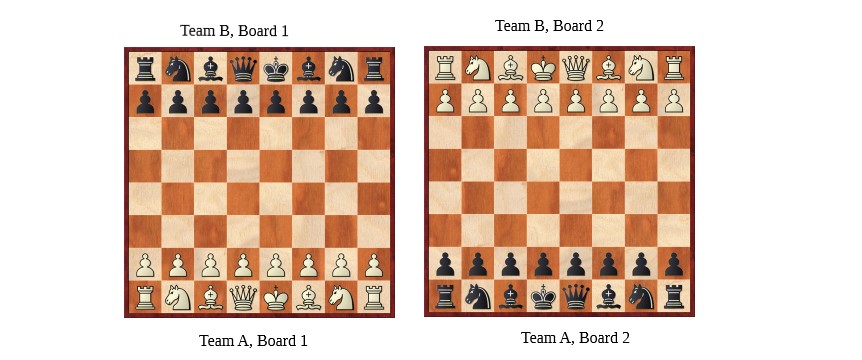


ChessBase 17 - Mega package - Edition 2024
It is the program of choice for anyone who loves the game and wants to know more about it. Start your personal success story with ChessBase and enjoy the game even more.
I use chess variants during my chess lessons because I believe in having a laugh now and then! And then dive into the depths of standard chess again. Moreover, how do you keep the interest in chess going if your student doesn't find solving chess puzzles (one after another) as entertaining as you do?
What if your students make the moves in standard chess just for the sake of it? They may not even have a clue that in chess we try to predict what's going to happen next. Or that we do quite a bit of planning. That's where a Double-Move game would come in handy!
I use chess variants as I believe in getting out of the comfort zone and giving the mind some work to do. In my Four-Way chess event, we don't even have the time control! I want to give players a chance to enjoy the challenge of playing against each without being a rush.
Do you struggle to calculate and to visualize positions? Play blindfold chess.
Still too hard? Try Half-Blindfold!
In any variant of chess, I recommend following the rules below.
1) The king can never be captured.
2) A check has to be parried with your next move.
Rules:
Players get two moves per turn.
If a check is given in the first of the two moves, the player loses his/her right to play the second move.
The player who is in check has to deal with it immediately before doing anything else. The king can not walk into check on the first move even if the second move would get it out of check again.
Pros:

A 4-Way chess board
Rules:
Four-Way chess is a fun version of standard chess. Four players play on a special board.
Normal chess rules apply, except:
1. The game is over and the winner is the one who checkmates any of the other three kings!
2. Your pawns promote on your 8th rank!
3. One player moves after the next, clockwise.
4. Partnering between any of the four players is not allowed. Everyone should play for himself/herself!
Pros:

One possible starting position in FischerRandom Chess
Rules:
FischerRandom chess is a fun version of classical chess where normal chess rules apply except:
1. The starting position of the pieces is random (generated by a chess program). There are 960 unique starting positions.
2. The two bishops of both players move on squares of opposite colours.
3. The castling rules of standard chess apply, however, the starting position of kings and rooks might differ from what we are used to. When castling kingside the king moves to g1 (g8) and the rook to f1 (f8), just like castling kingside in standard chess.
When castling queenside the king moves to c1 (c8) and the rook to d1 (d8), just like castling queenside in standard chess.

You may come across something like this in Half-Blindfold chess
Rules:
Players start their game on an empty chessboard, visualising the starting position. Every time they make a move, the piece they moved appears on the board. All other pieces remain invisible to the players.
Pros:
1. As the game progresses it is easy to spot pecularities of a player: is she/he hopping around with one piece; occupies the centre with pawns or plays with as many pieces as possible.
2. It is interesting to see who keeps track of all invisible pawns, especially when the middlegame is reached.

This is what you will see for the entire game!
Rules:
Two levels of difficulty:
1. It is easier to play with an empty chessboard in front of the players,
2. Advanced: no chess equipment is used. You announce your moves to your opponent.
Pros:

Rules:
Two players (Team A) play on two boards against another two players (Team B). In both teams one player plays with White, the other with Black. Captured pieces are given to one's teammate. The captured pieces and pawns you do receive from your teammate can be placed on the board in your game. Normal chess rules apply, except:
1. The captured pieces on one board are passed to your teammate.
2. Instead of making a move you can put/’drop’ any captured piece onto any vacant square, though pawns may not be dropped onto the first or the eighth rank.
3. Dropped pawns can be promoted. The pawn goes to your teammate after a promotion is completed.
4. A rook that is put to the original square of the rook is considered not to have moved and you can castle with such a rook.
5. The pieces you receive from your teammate should not be hidden from your opponent.
6. Pieces can NOT be dropped to give checkmate.
7. Checkmate or flagging on either board ends the match.
8. Clocks should be placed at each end so that all four players can see the time on both clocks.
9. Players should not help their teammates during the games. But a friendly chat is allowed!
Pros:
Hikaru Nakamura, Maxime Vachier-Lagrave, Levon Aronian and Maxim Dlugy have fun playing bughouse.
Rules:
The aim of this game is to lose all of your pieces except for your king!
Capturing the enemy pieces is compulsory. The players do their best to give their pieces away as soon as possible.
Pros: